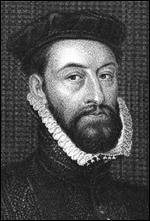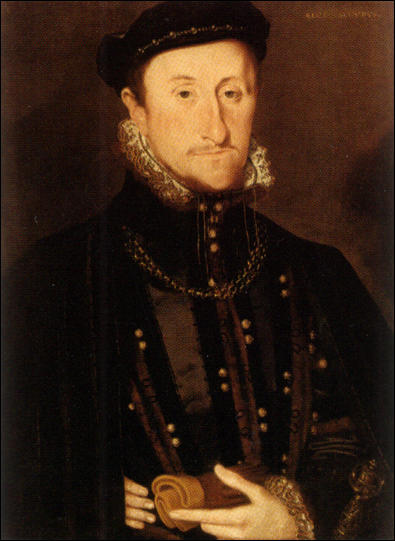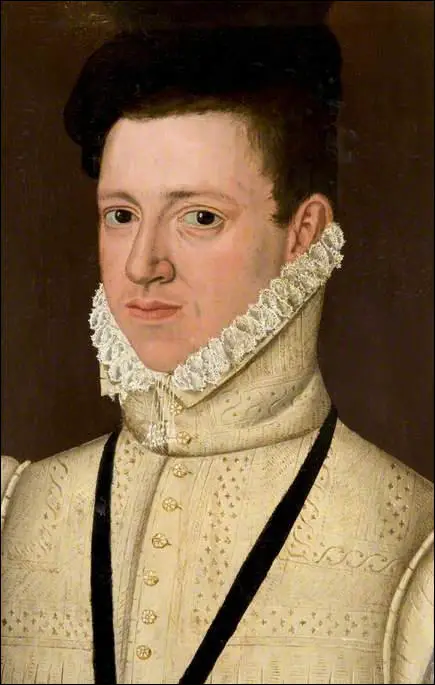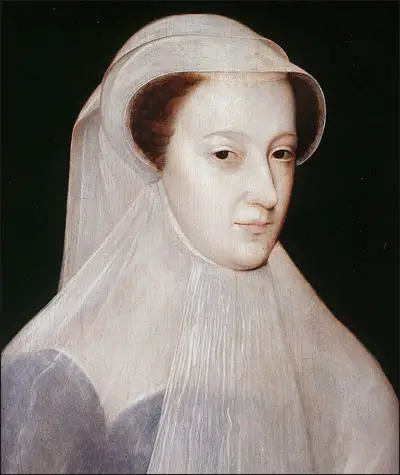James Stewart, Earl of Moray

James Stewart, the illegitimate son of James V of Scotland (1473–1513) and his mistress, Margaret Erskine, was probably born in 1531. When he was five years old he was granted the lands of Tantallon and two years he was appointed Prior of St Andrews which supplied his income.
Mary Stuart, the daughter of James V of Scotland and Mary of Guise, was born in Linlithgow, Scotland, in 1542. Her father died a few days later and she was immediately made queen of Scotland. James Hamilton, 2nd Earl of Arran, was appointed regent. However, his proposal to marry Mary to Edward, son of Henry VIII, was rejected by the Scottish parliament. (1)
Mary was now sent to France where she lived with the family of King Henri II. She was given a French education and on 4th April 1558, Mary signed a secret agreement bequeathing Scotland and her claim to England to the French crown if she died without issue. Three weeks later she married the king's eldest son, François. (2) Although omitted from the will of Henry VIII, she was one of the heiresses to the English crown. Henri believed that the marriage could result in a controlling interest in the combined realms of England and Scotland. (3)
James Stewart - Protestant
On 17th November 1558, Henry VIII's elder daughter, Queen Mary I died. She was succeeded by her sister, Elizabeth. In the opinion of many Catholics, Elizabeth was illegitimate, and Mary Stuart, as the senior descendant of Henry VIII's elder sister, was the rightful queen of England. Henri II of France proclaimed his eldest son and daughter-in-law king and queen of England, and in France the royal arms of England were quartered with those of Francis and Mary. (4) James Stewart became a supporter of the Scottish Reformation. At Perth in June 1559 he destroyed Catholic images in various churches.
On 10th July 1559, King Henri was killed by Gabriel Montgomery during a tournament. Mary's fifteen year old husband, François, became king of France. This development caused concern in England and urged on by William Cecil, Queen Elizabeth ordered an English fleet to cut the sea link between Scotland and France. She also issued instructions for assembling an army and after they invaded in the early months of 1560, negotiations between the countries took place. Under the terms of the Treaty of Edinburgh, signed in July, both France and England agreed to withdraw their forces from Scotland and leave the religious question to be settled by the Scottish Parliament. The body met in August and imposed the Reformation upon Scotland and the celebration of mass was forbidden. (5)
The following year François developed a middle ear infection which led to an abscess in his brain. He died on 5th December 1560. His mother, Catherine de Medici, became regent for his ten-year-old brother Charles IX, who inherited the French throne. She spent her period of strict mourning with her grandmother Antoinette. In January 1561, attempts were made to arrange a marriage with Don Carlos, eldest son of Philip II, but in April this was blocked by her mother-in-law.
Mary, Queen of Scots
John Leslie invited Mary, Queen of Scots to return to Scotland to restore Catholicism to the country. He promised that George Gordon, the 4th Earl of Huntly, would raise 20,000 men to help her gain power. Lord James Stewart, Mary's illegitimate half-brother and one of the protestant leaders, promised her that she could retain a private Catholic mass if she were to work with the regime. Anka Muhlstein has argued: "James Stewart was a Protestant but far from being a religious fanatic. Thoughtful and rather solemn by nature, he was well regarded in England." (6)
Mary accepted Lord James's offer and James Hepburn, 4th Earl of Bothwell, as lord high admiral, went to France to escort her home. She arrived at Leith on 19th August 1561. Five days later she heard mass in her chapel at Holyroodhouse, protected by Lord James from the threats of more militant protestants encouraged by John Knox. She governed with the aid of her privy council, that included James Stewart and William Maitland. (7) In September 1561 she made him Earl of Moray.

Soon after arriving in Scotland. Mary sent Maitland, her Secretary of State, to England to ask Elizabeth for the succession. Elizabeth told him that she knew no better right than Mary's, but that she did not want to nominate a successor because it would undermine her own position. Guided by Maitland, Mary presented her demands to Elizabeth as a simple clarification of the Treaty of Edinburgh. She would renounce the English throne in return for a clear promise of the succession.
Henry Darnley
In March, 1563, Maitland met with Queen Elizabeth to discuss who Mary, Queen of Scots' next husband should be. Elizabeth believed that Mary posed a threat to her throne and suggested her friend, Robert Dudley, Earl of Leicester. He was, she said, a model of everything that was manly, noble and fine. "Maitland, presumably not sure if Elizabeth was joking or not, responded that, as Robert was so much to her taste, the Scottish Queen could not deprive Elizabeth of such a jewel; she should marry Robert herself." Elizabeth was indeed serious and sent Thomas Randolph, the English Ambassador to Scotland, to discuss the matter with Mary. He passed on Elizabeth's own thoughts that "being determined to end her life in virginity, she wished that the queen her sister should marry him." (8)
Queen Elizabeth wanted Dudley to marry Mary because she thought she could control him. (9) Mary agreed to the idea but Randolph had more difficulty persuading Dudley. He still had hopes of marrying Elizabeth, and feared that if he agreed to accept Randolph's suggestion, she would turn on him for betraying her. Randolph reported back to Elizabeth, "Now that I have got this Queen's goodwill to marry where I would have her, I cannot get the man to take her for whom I was a suitor." (10)
Mary met Henry Stuart, Lord Darnley, on Saturday 17th February 1565, at Wemyss Castle in Scotland. Both Mary and Henry were grandchildren of Margaret Tudor, sister of Henry VIII of England, and the widow of James IV, king of Scots. Soon afterwards, arrangements were made for the two to marry. Queen Elizabeth was totally against the match because it would unite two claims on the throne. Any children of the marriage would inherit an even stronger, combined claim. At first Elizabeth was confident that she would block it because Darnley was an English subject, and his parents were her dependants with lands in England. (11) However, they married at Holyrood Palace on 29th July 1565, even though both were Catholic and a papal dispensation for the marriage of first cousins had not been obtained. (12)

Mary's marriage to a leading Catholic resulted in James Stewart, the Earl of Moray, to join with other Protestant lords in open rebellion. Mary and her forces and Moray and the rebellious lords roamed around Scotland without ever engaging in direct combat. Mary's numbers were boosted by the return of James Hepburn, 4th Earl of Bothwell, from exile in France. Mary's forces were greatly superior, and unable to obtain sufficient support, Moray left Scotland for asylum in England. (13)
4th Earl of Bothwell
On 24th April, 1567, Mary was abducted by James Hepburn, 4th Earl of Bothwell, and taken to Dunbar Castle. According to James Melville, who was in the castle at the time, later wrote that Bothwell "had ravished her and lain with her against her will". However, most historians do not believe that she was raped and argue that the abduction was arranged by Mary. Bothwell divorced his wife, Jean Gordon, and on 15th May, he married Mary at a protestant ceremony. (14)
People were shocked that Mary could marry a man accused of murdering her husband. Murder placards began appearing in Edinburgh, accusing both Mary and Bothwell of Darnley's death. Several showed the queen as a mermaid, the symbol for a prostitute. Her senior advisors in Scotland claimed that that they were unable to see the queen without Bothwell being present, and alleging that he was virtually keeping her prisoner. Rumours circulated that Mary was bitterly unhappy, repelled by her new husband's boorish behaviour, and overcome with remorse at having contracted a protestant marriage. (15)
Abdication
Twenty-six Scottish peers, turned against Mary and Bothwell, raising an army against them. Mary and Bothwell confronted the lords at Carberry Hill on 15th June, 1567. Clearly outnumbered, Mary and Bothwell surrendered. Bothwell was driven into exile and Mary was imprisoned in Lochleven Castle. While in captivity Mary miscarried twins. Her captors discussed several options: "conditional restoration; enforced abdication and exile; enforced abdication, trial for murder, and life imprisonment; enforced abdication, trial for murder, and execution". (16) On 24th July she was presented with deeds of abdication, telling her that she would be killed if she did not sign. She eventually agreed to abdicate in favour of her one-year-old son James. The Earl of Moray, was made regent. (17)

The Earl of Moray had no desire to keep the 24-year-old queen in prison for the rest of her life. On 2nd May 1568, she escaped from Lochleven Castle. She managed to raise an army of 6,000 men but was defeated at the Battle of Langside on 13 May. Three days later she crossed the Solway Firth in a fishing boat and landed at Workington. On 18th May, local officials took her into protective custody at Carlisle Castle. (18)
Queen Elizabeth was in a difficult position. She did not want the Catholic claimant to the English throne living in the country. At the same time she could not use her military forces to reimpose Mary's rule on the protestant Scots; nor could she allow Mary to take refuge in France and Spain, where she would be used as a "valuable pawn in the power game against England". There was no alternative but to keep the Queen of Scots in honourable captivity and in 1569 she was sent to Tutbury Castle under the guardianship of the George Talbot, 6th Earl of Shrewsbury. Mary was permitted her own domestic staff and her chambers were decorated with fine tapestries and carpets. (19)
Assassination of James Stewart, Earl of Moray
Mary, Queen of Scots still had supporters in Scotland. Earl of Moray set out on a military expedition in June 1568. This included the capturing houses belonging to supporters of Queen Mary. He also took control of Lochmaben Castle and the destruction of Rutherglen Castle. The following year he had more military successes and on 4th June, 1569, he held negotiations at Inverness.
Moray was at Stirling Castle. On 19th January 1570 he discussed with his military commanders the proposed attack on Dumbarton Castle, which was still held by supporters of Mary, Queen of Scots. (20) On 23rd January he visited Linlithgow. While on the main street he was shot by James Hamilton, with a carbine from the window of his uncle's house. Robert Birrel, wrote in his diary: "The Earl of Moray, the Good Regent, was slain in Linlithgow by James Hamilton of Bothwell-haugh, who shot the said Regent with a gun out at a window, and presently thereafter fled out at the back, and leapt on a very good horse." (21) It was the first recorded assassination by a firearm.
Student Activities
Codes and Codebreaking (Answer Commentary)
Why did Queen Elizabeth not get married? (Answer Commentary)
Primary Sources
(1) Anka Muhlstein, Elizabeth and Mary Stuart (2007)
This was when Mary discovered how violent rivalry between the Scottish clans could be. She wished to reward her half-brother for his loyalty by granting him the perous earldom of Moray. The title had fallen into abeyance and the land was administered by the Earl of Huntly. Furious at being deprived of a major source of income, Huntly took up arms against his sovereign. Although his son already had a wife, he felt confident of getting that obstructive marriage annulled and boasted that he would abduct Mary and marry her to him. James Stewart took command of the royal army, and the ensuing battle proved decisive: the rebels were routed and the Earl of Huntly was captured. Fatally wounded at that precise moment, he fell from his horse and died. His embalmed body was then conveyed to Edinburgh, where Parliament met to sit in judgement on the traitor. The fact that the traitor was a corpse did not prevent him from being tried. The coffin was stood on end in front of the parliamentarians, who pronounced Huntley guilty. They found a more animate culprit in the person of his son, who was likewise tried and condemned to be beheaded.
(2) Robert Birrel, quoted by Robert Chambers, Domestic Annals of Scotland (1858)
The Earl of Moray, the Good Regent, was slain in Linlithgow by James Hamilton of Bothwell-haugh, who shot the said Regent with a gun out at ane window, and presently thereafter fled out at the back, and leapt on a very good horse, which the Hamiltons had ready waiting for him; and, being followed speedily, after that spur and wand had failed him, he drew forth his dagger, and struck his horse behind; whilk causit the horse to leap a very broad stank; by whilk means he escaped.
